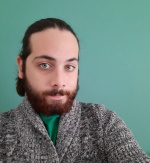opensearch:totalResults = 26
opensearch:startIndex = 0
opensearch:itemsPerPage = 25
@role = request
@searchTerms = AU-ID(57883960400)
@startPage = 0
@_fa = true
@ref = self
@href = https://api.elsevier.com/content/search/scopus?start=0&count=25&query=AU-ID%2857883960400%29&apiKey=6ae70c855c11cca26b94ca23c22dcbcf
@type = application/json
@_fa = true
@ref = first
@href = https://api.elsevier.com/content/search/scopus?start=0&count=25&query=AU-ID%2857883960400%29&apiKey=6ae70c855c11cca26b94ca23c22dcbcf
@type = application/json
@_fa = true
@ref = next
@href = https://api.elsevier.com/content/search/scopus?start=25&count=25&query=AU-ID%2857883960400%29&apiKey=6ae70c855c11cca26b94ca23c22dcbcf
@type = application/json
@_fa = true
@ref = last
@href = https://api.elsevier.com/content/search/scopus?start=1&count=25&query=AU-ID%2857883960400%29&apiKey=6ae70c855c11cca26b94ca23c22dcbcf
@type = application/json
inizio
@_fa = true
@_fa = true
@ref = self
@href = https://api.elsevier.com/content/abstract/scopus_id/105014517393
@_fa = true
@ref = author-affiliation
@href = https://api.elsevier.com/content/abstract/scopus_id/105014517393?field=author,affiliation
@_fa = true
@ref = scopus
@href = https://www.scopus.com/inward/record.uri?partnerID=HzOxMe3b&scp=105014517393&origin=inward
@_fa = true
@ref = scopus-citedby
@href = https://www.scopus.com/inward/citedby.uri?partnerID=HzOxMe3b&scp=105014517393&origin=inward
@_fa = true
@ref = full-text
@href = https://api.elsevier.com/content/article/eid/1-s2.0-S1566253525007225
- Towards neural foundation models for vision: Aligning EEG, MEG, and fMRI representations for decoding, encoding, and modality conversion; Information Fusion; February 2026; DOI: 10.1016/j.inffus.2025.103650
prism:url = https://api.elsevier.com/content/abstract/scopus_id/105014517393
dc:identifier = SCOPUS_ID:105014517393
eid = 2-s2.0-105014517393
dc:creator = Ferrante M.
prism:publicationName = Information Fusion
prism:issn = 15662535
prism:eIssn =
prism:volume = 126
prism:issueIdentifier =
prism:pageRange =
prism:coverDate = 2026-02-01
prism:coverDisplayDate = February 2026
prism:doi = 10.1016/j.inffus.2025.103650
citedby-count = 0
@_fa = true
affilname = Università degli Studi di Roma "Tor Vergata"
affiliation-city = Rome
affiliation-country = Italy
pubmed-id =
prism:aggregationType = Journal
subtype = ar
subtypeDescription = Article
article-number = 103650
source-id = 26099
openaccess = 1
openaccessFlag = true
value:
$ = all
$ = publisherhybridgold
value:
$ = All Open Access
$ = Hybrid Gold
prism:isbn:
@_fa =
$ =
pii = S1566253525007225
inizio
@_fa = true
@_fa = true
@ref = self
@href = https://api.elsevier.com/content/abstract/scopus_id/105013869712
@_fa = true
@ref = author-affiliation
@href = https://api.elsevier.com/content/abstract/scopus_id/105013869712?field=author,affiliation
@_fa = true
@ref = scopus
@href = https://www.scopus.com/inward/record.uri?partnerID=HzOxMe3b&scp=105013869712&origin=inward
@_fa = true
@ref = scopus-citedby
@href = https://www.scopus.com/inward/citedby.uri?partnerID=HzOxMe3b&scp=105013869712&origin=inward
- Evidence for compositionality in fMRI visual representations via Brain Algebra; Communications Biology; December 2025; DOI: 10.1038/s42003-025-08706-4
prism:url = https://api.elsevier.com/content/abstract/scopus_id/105013869712
dc:identifier = SCOPUS_ID:105013869712
eid = 2-s2.0-105013869712
dc:creator = Ferrante M.
prism:publicationName = Communications Biology
prism:issn =
prism:eIssn = 23993642
prism:volume = 8
prism:issueIdentifier = 1
prism:pageRange =
prism:coverDate = 2025-12-01
prism:coverDisplayDate = December 2025
prism:doi = 10.1038/s42003-025-08706-4
citedby-count = 0
@_fa = true
affilname = Università degli Studi di Roma "Tor Vergata"
affiliation-city = Rome
affiliation-country = Italy
pubmed-id = 40847014
prism:aggregationType = Journal
subtype = ar
subtypeDescription = Article
article-number = 1263
source-id = 21100924827
openaccess = 1
openaccessFlag = true
value:
$ = all
$ = publisherfullgold
$ = repository
$ = repositoryam
value:
$ = All Open Access
$ = Gold
$ = Green
prism:isbn:
@_fa =
$ =
pii =
inizio
@_fa = true
@_fa = true
@ref = self
@href = https://api.elsevier.com/content/abstract/scopus_id/85219197026
@_fa = true
@ref = author-affiliation
@href = https://api.elsevier.com/content/abstract/scopus_id/85219197026?field=author,affiliation
@_fa = true
@ref = scopus
@href = https://www.scopus.com/inward/record.uri?partnerID=HzOxMe3b&scp=85219197026&origin=inward
@_fa = true
@ref = scopus-citedby
@href = https://www.scopus.com/inward/citedby.uri?partnerID=HzOxMe3b&scp=85219197026&origin=inward
- Transforming Multimodal Models into Action Models for Radiotherapy; Lecture Notes in Computer Science Including Subseries Lecture Notes in Artificial Intelligence and Lecture Notes in Bioinformatics; 2025; DOI: 10.1007/978-3-031-82007-6_5
prism:url = https://api.elsevier.com/content/abstract/scopus_id/85219197026
dc:identifier = SCOPUS_ID:85219197026
eid = 2-s2.0-85219197026
dc:creator = Ferrante M.
prism:publicationName = Lecture Notes in Computer Science Including Subseries Lecture Notes in Artificial Intelligence and Lecture Notes in Bioinformatics
prism:issn = 03029743
prism:eIssn = 16113349
prism:volume = 15384 LNCS
prism:issueIdentifier =
prism:pageRange = 41-53
prism:coverDate = 2025-01-01
prism:coverDisplayDate = 2025
prism:doi = 10.1007/978-3-031-82007-6_5
citedby-count = 0
@_fa = true
affilname = Università degli Studi di Roma "Tor Vergata"
affiliation-city = Rome
affiliation-country = Italy
pubmed-id =
prism:aggregationType = Book Series
subtype = cp
subtypeDescription = Conference Paper
article-number =
source-id = 25674
openaccess = 0
openaccessFlag = false
value:
$ =
value:
$ =
prism:isbn:
@_fa = true
$ = [9783031820069]
pii =
inizio
@_fa = true
@_fa = true
@ref = self
@href = https://api.elsevier.com/content/abstract/scopus_id/85215663825
@_fa = true
@ref = author-affiliation
@href = https://api.elsevier.com/content/abstract/scopus_id/85215663825?field=author,affiliation
@_fa = true
@ref = scopus
@href = https://www.scopus.com/inward/record.uri?partnerID=HzOxMe3b&scp=85215663825&origin=inward
@_fa = true
@ref = scopus-citedby
@href = https://www.scopus.com/inward/citedby.uri?partnerID=HzOxMe3b&scp=85215663825&origin=inward
- Effective Dose Estimation in Computed Tomography by Machine Learning; Tomography; January 2025; DOI: 10.3390/tomography11010002
prism:url = https://api.elsevier.com/content/abstract/scopus_id/85215663825
dc:identifier = SCOPUS_ID:85215663825
eid = 2-s2.0-85215663825
dc:creator = Ferrante M.
prism:publicationName = Tomography
prism:issn = 23791381
prism:eIssn = 2379139X
prism:volume = 11
prism:issueIdentifier = 1
prism:pageRange =
prism:coverDate = 2025-01-01
prism:coverDisplayDate = January 2025
prism:doi = 10.3390/tomography11010002
citedby-count = 1
@_fa = true
affilname = Istituto Europeo di Oncologia
affiliation-city = Milan
affiliation-country = Italy
pubmed-id = 39852682
prism:aggregationType = Journal
subtype = ar
subtypeDescription = Article
article-number = 2
source-id = 21100904813
openaccess = 1
openaccessFlag = true
value:
$ = all
$ = publisherfullgold
$ = repository
value:
$ = All Open Access
$ = Gold
$ = Green
prism:isbn:
@_fa =
$ =
pii =
inizio
@_fa = true
@_fa = true
@ref = self
@href = https://api.elsevier.com/content/abstract/scopus_id/105016789980
@_fa = true
@ref = author-affiliation
@href = https://api.elsevier.com/content/abstract/scopus_id/105016789980?field=author,affiliation
@_fa = true
@ref = scopus
@href = https://www.scopus.com/inward/record.uri?partnerID=HzOxMe3b&scp=105016789980&origin=inward
@_fa = true
@ref = scopus-citedby
@href = https://www.scopus.com/inward/citedby.uri?partnerID=HzOxMe3b&scp=105016789980&origin=inward
- Generation of synthetic TSPO PET maps from structural MRI images; Frontiers in Neuroinformatics; 2025; DOI: 10.3389/fninf.2025.1633273
prism:url = https://api.elsevier.com/content/abstract/scopus_id/105016789980
dc:identifier = SCOPUS_ID:105016789980
eid = 2-s2.0-105016789980
dc:creator = Ferrante M.
prism:publicationName = Frontiers in Neuroinformatics
prism:issn =
prism:eIssn = 16625196
prism:volume = 19
prism:issueIdentifier =
prism:pageRange =
prism:coverDate = 2025-01-01
prism:coverDisplayDate = 2025
prism:doi = 10.3389/fninf.2025.1633273
citedby-count = 0
@_fa = true
affilname = Università degli Studi di Roma "Tor Vergata"
affiliation-city = Rome
affiliation-country = Italy
pubmed-id =
prism:aggregationType = Journal
subtype = ar
subtypeDescription = Article
article-number = 1633273
source-id = 19700175167
openaccess = 1
openaccessFlag = true
value:
$ = all
$ = publisherfullgold
value:
$ = All Open Access
$ = Gold
prism:isbn:
@_fa =
$ =
pii =
